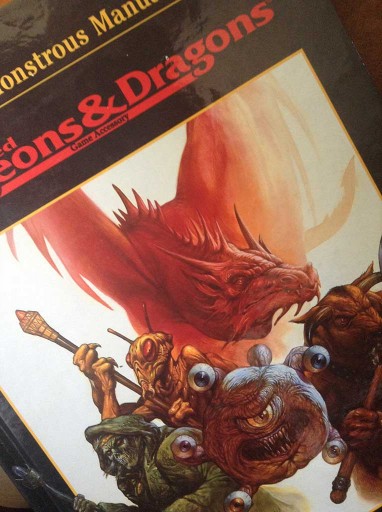Yesterday we had Day Three, and that can only mean one thing. It’s Day Four! We are taking a week-long look at the freely downloadable D&D Basic pdf, and we are halfway there. Its time to smash some skulls!
One of the strengths of this edition of Dungeons & Dragons is that it’s possible, in theory at least, to take adventures and monsters from any prior edition, and use them with the minimum of fuss or conversion. I’d say that holds true (especially at lower levels), with a few caveats.
If the monster is from AD&D or prior then you’re going to have to convert the Armour Class. That’s no biggie, and can be done on the fly. Apparently there will be rules in the DMG to use or convert (it’s unclear which) descending AC but for now just deduct the given AC from 20 and you’re there. If that feels too high in play, adjust to taste. Give the critter a hit bonus equal to Hit Dice + proficiency bonus, and you’re done.
If you’re using Fourth Edition monsters warn the players, quarter their hit points, deduct 3 from their AC and halve their damage. 4e is Wushu D&D where everything is bigger, so you have to adjust back down accordingly.
We will revisit using older edition adventures and Monster Manuals when the DMG and MM are released. Watch this space!
There are key yet subtle differences between all editions of D&D when it comes to abilities and damage output so it’s worth finding a level you’re happy with as a group and sticking with that. If Fifth Edition D&D using the AD&D Monstrous Manual floats your boat, more power to you!

Depending on which edition of D&D you’re familiar with, Basic D&D combat might be either more or less complex than you’re used to. It treads the happy middle ground between all editions, or as I like to call it “kinda like 3th edition”. The focus here is on fast, fluid imaginative play, though it’s welcome to see gridded combat and the use of miniatures as a prominent option. Both styles of play are equally valid and it’s possible to mix and match between the two (perhaps using a dungeon diorama for the final climactic battle) as required.
The key difference between earlier editions is that it’s possible to split your movement however you want during your turn. An archer with Speed 30′ could, for example, move 15′, fire an arrow, move another 15′ then drop prone all as a part of their turn. The next round they could stand (costing half their movement), shoot, move 15′ if they need to, then drop prone again. Any ranged attacks against you have disadvantage while you’re prone so provided you keep your distance it’s a worthwhile tactic to use.
Combat doesn’t always mean you have to hit something your turn (though it’s generally quite a good idea). If your attacks can’t damage the foe, you’re out of spells or need to ensure the Rogue makes her Sneak attack on her turn, there’s a whole variety of options listed in the Combat chapter. It’s worth remembering it is a far from complete list – players are free to do whatever the heck they want, and it’s down to the GM to adjudicate the results of the actions.
The actions listed are:
- Attack
- Cast a spell
- Dash
- Disengage
- Dodge
- Help
- Hide
- Ready
- Search
- Use an object
The most interesting ones (aside from Attack and Cast a spell, of course) are Help and Ready. Help gives advantage to the next ability check or attack of a selected ally – useful for setting up the Rogue, help to disarm the mechanism that’s causing the ceiling to drop or any number of countless other tasks. Readied actions hold what you’re doing until a certain trigger occurs. It’s worth noting that spells are cast immediately, but then the magical energies are held within until the trigger happens. It’s probably not a good idea to startle a Wizard holding in a Fireball spell!
Overall, combat in D&D Basic is exactly as you’d expect and that’s a Good Thing. Initiative is rolled, toss a d20+ bonuses against AC to see if you hit then roll for damage. It’s comfort-blanket gaming at its finest. Any there’s not a single thing wrong with that, at all.
Next time we take a look at campaign settings, both express and implied, and how we can use Basic D&D to build our own game world.
Till then!




still getting lost in magic.
the wizard has an attack number yet most spell just have saving throws. who remembers that . player or GM.
I suffer terrible memory issues.
I’ll probably write the to hit number by those few spells with attack rolls on my spell list, or write the save type. The one thing I’m not entirely sold on in 5e is the verbose spell descriptions, though they do give more room for flavour than 4e ones. Spell cards would still work, and a hand of prepared spells with a deck of spells in the spellbook (or at that level for clerics) makes sense.
we created spell cards for our games but as the druid had all spells in hand and had to keep swapping out which she chose each time it became a pain in the deck